In a recent study, researchers found that outcomes of patients with clear cell renal cell carcinoma may be predicted by the spatial arrangement of immune cells in the tumour microenvironment (Figure 1).

Figure 1: Overview of the demographics and selected findings from the overall cohort. Listed in descending order: SSIGN risk score, age, gender, pT stage, ISUP histological grade, sarcomatoid variant status, overall survival (months), vitality status, xCell bulk RNA-seq immune expression scores, multiplex immunofluorescence cellular density in the tumor-core, and somatic mutation alteration status. xCell scores and mIF cell densities have been normalized to a 0–100 scale, as indicated by the color scale in the legend. mIF, multiplex immunofluorescence; OS, overall survival. SSIGN = Stage, Size, Grade and Necrosis score; ISUP = International Society of Urologic Pathology.
The standard of treatment for many cancer types, including clear cell renal cell carcinoma, has significantly changed as a result of immunotherapies that mobilise immune cells against cancer cells. A number of indicators, including PD-L1 protein expression levels and the presence of CD8+ T cells, have been linked to better treatment results with this kind of therapy. However, clear cell renal cell carcinoma has not shown a good prognostic value for these biomarkers.
Numerous immune cell subtypes make up the tumour immunological microenvironment. While some, like CD8+ T cells, have anticancer properties, others, like M2-like tumor-associated macrophages, have pro-tumour properties. The interactions between these many cell types are probably crucial, as patient outcomes to therapy are not entirely reliant on the presence or absence of these cell types.
In order to precisely map the spatial organisation and distributions of immune cells in respect to tumour cells and the stroma, the research team employed an experimental strategy that retained the clear cell renal cell carcinoma tumour tissue.
Using this data, the researchers created a score that could forecast the clustering of tumor-associated macrophages based on the expression of 20 genes. They verified the correlation between gene expression, illness stage, and survival by validating the score in various independent patient groups.
Journal article: Chakiryan. N.H., et al., 2023. Geospatial characterization of immune cell distributions and dynamics across the microenvironment in clear cell renal cell carcinoma, Journal for ImmunoTherapy of Cancer.
Summary by Stefan Botha










